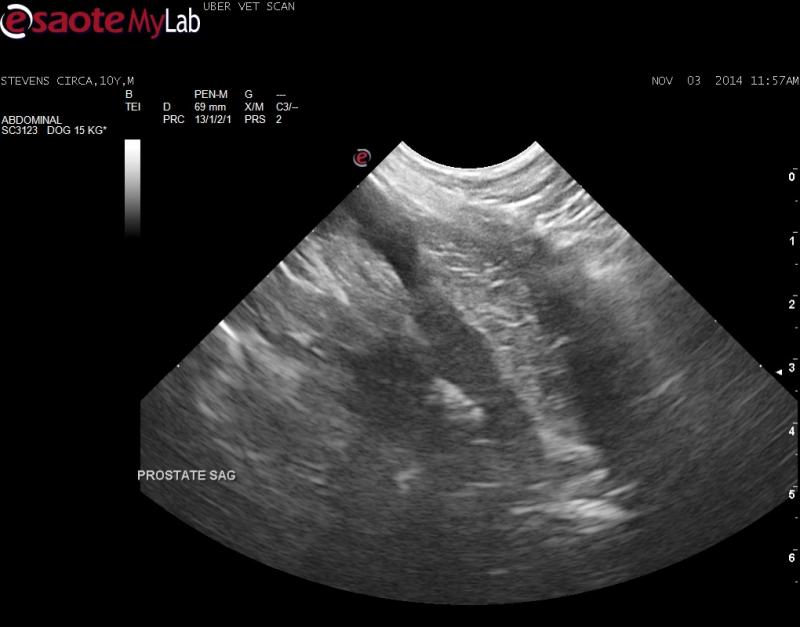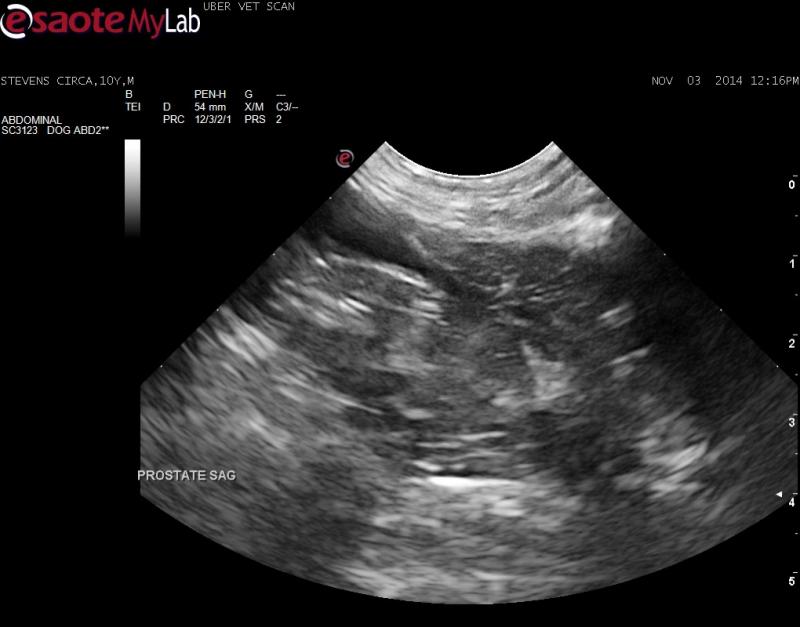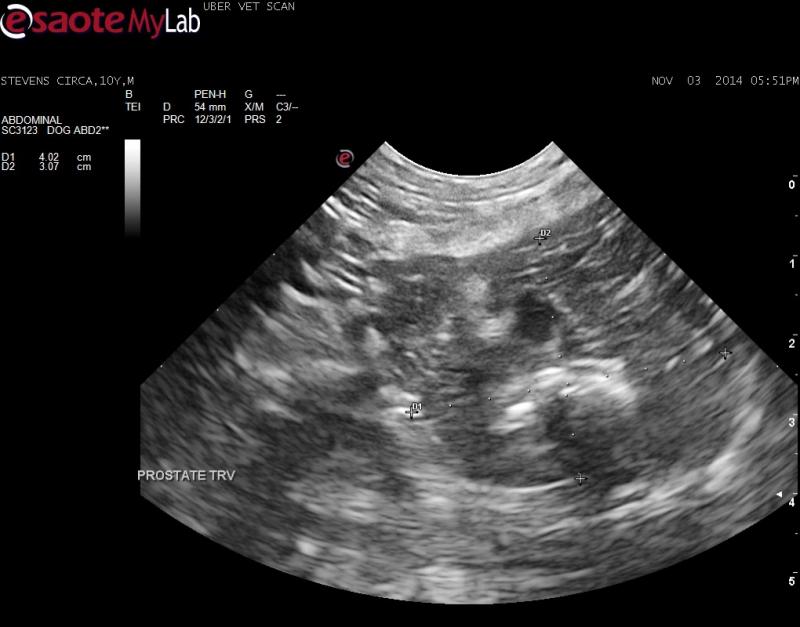– 10 year old MN Boston Terrier w history decreased appetite and unexplained weight loss
– no v/d/c/s/pu/pd – passing urine and stool normally
– bloodwork unremarkable; prostate not palpable rectally
– mineralized lesion seen in prostate therefore concern of neoplasia as pet is neutered
– medical iliac LN’s were not identified and rest of scan including kidneys were normal
– FNA of prostate pending
What is your opinion on the look of this prostate?
– 10 year old MN Boston Terrier w history decreased appetite and unexplained weight loss
– no v/d/c/s/pu/pd – passing urine and stool normally
– bloodwork unremarkable; prostate not palpable rectally
– mineralized lesion seen in prostate therefore concern of neoplasia as pet is neutered
– medical iliac LN’s were not identified and rest of scan including kidneys were normal
– FNA of prostate pending
What is your opinion on the look of this prostate?




Comments
In the video and the urethra
In the video and the urethra and residual prostate I see normal regression and normal urethra. The mineralization and focal hyperechoic change is in the pelvic fat. I don’t see anything here that is causing the weight loss.
In the video and the urethra
In the video and the urethra and residual prostate I see normal regression and normal urethra. The mineralization and focal hyperechoic change is in the pelvic fat. I don’t see anything here that is causing the weight loss.
Thanks Eric
I don’t have the
Thanks Eric
I don’t have the cytology results back but the FNA’s did look pretty oily/fatty so I suspect they will come back as fat. Weird place for mineral?
Thanks Eric
I don’t have the
Thanks Eric
I don’t have the cytology results back but the FNA’s did look pretty oily/fatty so I suspect they will come back as fat. Weird place for mineral?
I have seen mesenteric fat
I have seen mesenteric fat that was mineralized on abdominal x-rays. Sometimes you can tell it is in the fat because the mineralization is not associated with any organ. I will see if I can did up the x-rays and post it here. I even submitted the x-rays for a radiologist interpretation.
I have seen mesenteric fat
I have seen mesenteric fat that was mineralized on abdominal x-rays. Sometimes you can tell it is in the fat because the mineralization is not associated with any organ. I will see if I can did up the x-rays and post it here. I even submitted the x-rays for a radiologist interpretation.
Here are the x-rays of the
Here are the x-rays of the cat. I reveiwed the radiologist report and these were called mineralized mesenteric cysts. I had never seen this before.
Here are the x-rays of the
Here are the x-rays of the cat. I reveiwed the radiologist report and these were called mineralized mesenteric cysts. I had never seen this before.
cool…looks like they are in
cool…looks like they are in the position of a bates body… mineralized bates body?
cool…looks like they are in
cool…looks like they are in the position of a bates body… mineralized bates body?
Yes- they appear to be “Bates
Yes- they appear to be “Bates Bodies”. I had never heard that term before. Maybe they are not cysts but areas of fat necrosis with subsequent mineralization. Below is a definition taken from the internet from “VetRadiology”. There are also lots of x-rays showing this in cats mostly. Thanks EL- your knowledge never ceases to amaze me.
“In cats, round to ovoid abdominal masses with a thin, mineralized wall ( “egg shell”) are nearly always areas of nodular fat necrosis. These lesions are also referred to as Bates bodies. The true etiology for the fat mineralization is unknown but is assumed to be secondary to fat cell degeneration from local inflammation or ischemia. These are incidental findings in cats and are rarely seen in dogs. When mineralized, these structures can also be seen on abdominal ultrasound as a region of thin hyperechoic shell with a central hypoechoic region. Occasionally, round hyperechoic/hypoechoic lesions will be identified in abdominal fat on ultrasound before they are mineralized and recognizable on radiographs. The lesions can vary from a few millimeters to several centimeters in size and are always in a region of abdominal fat. Lateral and ventral dorsal radiographs are necessary to confirm that the structure is in abdominal fat and not the intestinal tract, the bladder or other organs.”
Yes- they appear to be “Bates
Yes- they appear to be “Bates Bodies”. I had never heard that term before. Maybe they are not cysts but areas of fat necrosis with subsequent mineralization. Below is a definition taken from the internet from “VetRadiology”. There are also lots of x-rays showing this in cats mostly. Thanks EL- your knowledge never ceases to amaze me.
“In cats, round to ovoid abdominal masses with a thin, mineralized wall ( “egg shell”) are nearly always areas of nodular fat necrosis. These lesions are also referred to as Bates bodies. The true etiology for the fat mineralization is unknown but is assumed to be secondary to fat cell degeneration from local inflammation or ischemia. These are incidental findings in cats and are rarely seen in dogs. When mineralized, these structures can also be seen on abdominal ultrasound as a region of thin hyperechoic shell with a central hypoechoic region. Occasionally, round hyperechoic/hypoechoic lesions will be identified in abdominal fat on ultrasound before they are mineralized and recognizable on radiographs. The lesions can vary from a few millimeters to several centimeters in size and are always in a region of abdominal fat. Lateral and ventral dorsal radiographs are necessary to confirm that the structure is in abdominal fat and not the intestinal tract, the bladder or other organs.”
Thx for the compliment
Thx for the compliment Randy:) I try
Thx for the compliment
Thx for the compliment Randy:) I try
Thank-you Randy – this may
Thank-you Randy – this may indeed be a dog bates body.
Thank-you Randy – this may
Thank-you Randy – this may indeed be a dog bates body.